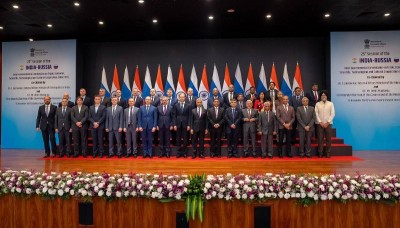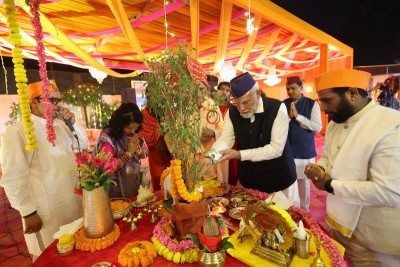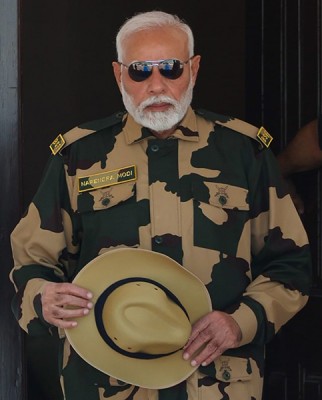
Assam: Troubles Persist
On December 28, 2016, an NDFB-IKS militant, identified as Ratan Narzary was killed during a gun fight with Security Forces (SFs) in Kokrajhar District. Kokrajhar Superintendent of Police (SP) Rajen Singh stated that a joint team of the 7thBattalion of the Sikh Light Infantry (LI) regiment and Kokrajhar Police, based on specific information regarding the movement of NDFB-IKS, launched a joint operation at Ashrabari (Laopani area) under the Bismuri Police Outpost in the morning of December 28 and a group of 3 or 4 suspected cadres of the outfit were seen moving in the area. The militants opened fire on the joint team on being challenged, and the ambush party fired back. The exchange of fire that lasted for about 15 minutes, and SF's recovered one AK-56 assault rifle, a magazine, 11 live ammunition, nine fired cases, one hand grenade, a bag, a blanket, two mobile phones and two active SIM cards. However, villagers started protests against the killing, claiming that he was not associated with any militant organisation and demanded a probe into the killing. On December 30, 2016, Chief Minister (CM) Sarbananda Sonowal instructed the Commissioner, Lower Assam, Mohammad M.U. Ahmed to conduct a probe into the incident.
On December 10, 2016, two NDFB-IKS militants were killed in an encounter with a joint team of the Assam Police and Army in the deep jungles along the Indo-Bhutan border in Kokrajhar District. On a tip-off, SFs launched an operation inside the Kochugaon Reserve Forest in the Oksiguri area in the early hours and a group of four insurgents exchanged fire with the security team. Two of the militants were killed on the spot, Bodoland Territorial Area District (BTAD) Inspector General of Police (IGP) L.R. Bishnoi disclosed. An AK-56 rifle with 21 rounds of live ammunition, and one 7.65 mm pistol with one magazine containing three rounds of live ammunition were recovered from the slain militants.
Crucially, in terms of insurgency/militancy-related violence, Assam is the only State in the Northeast region which recorded higher fatalities during 2016, as compared to the preceding year. According to partial data compiled by the South Asia Terrorism Portal (SATP), in 2016, the State registered a total of 86 fatalities, including 33 civilians, four SF personnel and 49 militants. In comparison, 2015 had recorded a total of 59 killings, including 10 civilians, one SF trooper and 48 militants. In 2015, the State had recorded the lowest insurgency-related fatalities since 1992 [the year since which SATP data is available]. No killing has been registered in the state in the current year 2017, till date (Data updated till January 8, 2017).
Worryingly, the number of civilian fatalities in the state increased sharply to 33 in 2016 from 10 in 2015. Last year's civilian toll was also the lowest since 1992; 184 civilian fatalities were recorded in 2014. In one of the worst terrorist attack on the civilians since the December 23, 2014, Adivasi massacre, suspected NDFB-IKS militants opened indiscriminate fire at the crowded Balajan Tiniali Weekly (Friday) Market in Kokrajhar District on August 5, 2016, killing 14 persons, including two women, and injuring another 20. According to eyewitnesses, there were four to five terrorists in military fatigues, armed with sophisticated weapons, who fired at the crowd in the market at around 11.30 am. Personnel of the 3rd Rajput Regiment based in Kokrajhar, who were passing through the market, started retaliatory firing, killing one terrorist, while the others managed to escape. Significantly, only one major incident (involving three or more fatalities) was reported with civilian fatalities between December 23, 2014, and August 5, 2016: on April 4, 2016, at least three persons were killed and over twenty were injured in a powerful grenade attack by the Independent faction of United Liberation Front of Asom (ULFA-I) at Dudhnoi in Goalpara District.
Similarly, SF fatalities also increased from one in 2015 to four in 2016. In the worst incident of this nature in 2016, on November 19, three Army personnel were killed and another four were injured when militants ambushed an Army convoy at Pengaree near Digboi in Tinsukia District.
Due to sustained operations by SFs in the State, 49 militants belonging to various insurgent groups lost their lives during 2016, as against 48 in 2015. Of the 49 militants killed, NDFB-IKS lost the largest number, 22; followed by Karbi People's Liberation Tigers (KPLT), 11; three cadres each of the ULFA-I and the Khaplang faction of National Socialist Council of Nagaland (NSCN-K); two cadres each of the Bru National Liberation Front (BNLF), People's Liberation Front of Meghalaya (PLF-M), Reformation faction of National Socialist Council of Nagaland (NSCN-R); and one cadre each of National Santhal Liberation Army (NSLA), United Democratic Liberation Army (UDLA), Kamtapur Liberation Organization (KLO), and United People's Liberation Army (UPLA). In one of the most successful operations in recent times, on September 23, 2016, the Indian Army along with personnel of the Assam Police, killed at least six KPLT militants including two of its "top leaders" according to Police sources, in a swift and surgical operation in the Nambar Reserve Forest in East Karbi Anglong District.
SFs also arrested 490 militants of various outfits in Assam through 2016. These included 152 of NDFB-IKS; followed by ULFA-I, 61; Jama'atul Mujahideen Bangladesh (JMB), 24; National Santhal Liberation Army (NSLA), 23; KPLT, 18; Helem Tiger Force (HTF), 11; Kamtapur Liberation Organization (KLO), 10. In 2015, a total of 602 militants had been arrested in the State. 'Operation All Out', launched by SFs to flush out militants after the NDFB-IKS militants massacred over 69 Adivasis on December 23, 2014, in which the Indian Air Force, Army, Paramilitary Forces and State Police have worked together, continues.
On June 29, 2016, the Army claimed that, in a series of joint operations with the Assam Police over the preceding days, 11 militants of the recently-floated HTF were arrested from Umrongso in Dima Hasao District and Larkercha village in West Karbi Anglong District along the Assam-Meghalaya border. HTF reportedly has close links with the KPLT and UPLA. After the arrests, Army sources disclosed that the unearthing and arrest of a majority of cadres of this outfit, has been a major setback for the nexus between these groups, which have been involved in abduction, extortion and 'tax-collection'. However, SFs failed to arrest the kingpin of this new outfit.
Other parameters of violence also recorded slight increases as well. The year 2016 saw seven major incidents (each involving three or more fatalities) resulting in 37 deaths, as against just two such incidents, accounting for six deaths in 2015. The number of Districts from where insurgency-related fatalities were reported stood at 14 in 2016 as against 13 in 2015, out of a total of 35 Districts in the State (including three new Districts created in 2016; East Kamrup, South Kamrup and Majuli). The Districts from where incidents of killing were reported in 2016 were Kokrajhar (34), Tinsukia (12), East Karbi Anglong (12), Goalpara (7), Sonitpur (5), Chirang (4), Hailakandi (4), Udalguri (3), Darrang (1), Nagaon (1), Nalbari (1), West Karbi Anglong (1), and Jorhat (1). Further, the number of explosions reported in 2016 was 11, as against six in 2015, and resultant fatalities increased from two in 2015 to six in 2016.
On the other hand, reported incidents of abduction and extortion by militants registered a slight decline. According to Assam Police records, there were 4,704 cases of abductions registered in the State in 2016 (data till September); as against 6,103 cases in 2015. Further, there were 989 extortion-related cases registered in 2016 (data till September); as against 1,361 in 2015. Though most of the abductions were carried out by criminals, the Police records did not rule out the role of militant outfits of the region in some of the incidents. Many incidents of abduction and extortion go unreported, and these numbers are likely a gross underestimate.
Reports also indicate that many of the militant groups in the region were coming together to fight jointly for the 'sovereignty' of their respective imagined states. After the November 19, 2016, Pengaree attack, in which three SF personnel were killed, ULFA-I claimed that this was a "joint operation" carried out by the its cadres and four members of the Manipur-based Coordination Committee (CorCom) - comprising the Revolutionary People's Front (RPF, the political wing of the People's Liberation Army, PLA), United National Liberation Front (UNLF), People's Revolutionary Party of Kangleipak (PREPAK), and the progressive faction of PREPAK (PREPAK-Pro). The other two members of the CorCom, a conglomerate of six Manipur Valley-based militant outfits, are the Kangleipak Communist Party (KCP) and the Kanglei Yawol Kanna Lup (KYKL). The same group also carried out a second attack on the Army in the Chandel District of Manipur on November 26, 2016, and injured five SF personnel. The attacks, codenamed 'Operation Barak', were the first instance of Meitei groups carrying out a terror strike in Assam and ULFA-I operating in Manipur. On December 3, 2016,the 'commander-in-chief' of ULFA-I, Paresh Baruah, clarified that "Operation Barak, named after the Barak River that flows from Manipur to Assam, is a symbol of friendship between the two States."
ULFA-I, NDFB-IKS, KLO and the Khaplang faction of the National Socialist Council of Nagaland (NSCN-K) had also jointly formed the United National Liberation Front of Western South East Asia (UNLFWSEA), a common front of militant groups in India's Northeast region. Different ethnic armed groups (EAGs) continued with their efforts to engage in disruptive activities and had formed this united platform and they were also attempting to develop a nexus with transnational jihadi groups and Maoists, increasing the threat potential in the Assam and the wider Northeast region. A new militant outfit that seeks a separate sovereign nation for the Karbi people by segregating the portion of land from Assam, the People's Democratic Council of Karbilongri (PDCK) was formed on October 27, 2016, and also joined UNLFWSEA. The plan to make UNLFWSEA bigger indicates a possibility of heightened militancy in the region in the foreseeable future.
An incipient threat of Islamist terrorism from within, from neighboring States, as well as from bordering countries, has exacerbated risks in Assam as well. On April 20, 2016, the Chirang Police arrested seven suspected cadres of JMB from two different areas in the Chirang District of Assam. Five of them were arrested from the Dawkanagar area; another two, including the imam (prayer leader) of Rajapara Masjid (mosque), were arrested from the Amguri area. Bodoland Territorial Administrative Districts (BTAD) IGP L.R. Bishnoi stated, "All these jihadis were operating in Assam under Bangladesh-based jihadi module JMB. They had set up a camp for imparting physical training and there were plans to impart arms training later. Two people came from West Bengal to impart training to the jihadis here. We have got their names and addresses and we are in touch with our counterparts in West Bengal to arrest them". The JMB modules were exposed in a countrywide crackdown in the aftermath of the October 2, 2014, Burdwan blast in West Bengal.
According to SATP data, at least 36 Islamist extremists, including 24 JMB cadres, six of the Muslim Tiger Force of Assam (MTFA), one each of the Islamic State of Iraq and Syria (ISIS), Muslim United Liberation Tigers of Assam (MULTA), and Indian Mujahideen (IM); and another three whose affiliations were unidentified, were arrested during the year 2016.
In a positive move, India and Bangladesh exchanged a list of wanted terrorists suspected to be hiding in both the countries during the two-day Home Secretary level talks between the two countries held in New Delhi on December 5-6, 2016. During the talks, Union Home Secretary Rajiv Mehrishi handed over a list of terrorists, including several ULFA-I leaders, along with a list of 45 militant hideouts in Bangladesh, and urged Dhaka to take immediate measures for handing over jailed Northeast militants. Dhaka on its part shared a list of home grown terrorists, particularly JMB cadres, suspected to be holed up in India. The neighbouring countries also decided to set up a joint anti-terror mechanism to combat terrorism and radical elements.
While the Union Ministry of Home Affairs (UMHA) is working to seal the entire border with Bangladesh over the next two years, the State Government is also contemplating measures to harden the border areas against infiltration. On January 1, 2017, Assam Director General of Police (DGP) Mukesh Sahay revealed that around 4,000 personnel would be recruited to create a strong second line of defence to guard the international border with Bangladesh. The recruitment process is likely to be completed in financial year 2017-18. In each of the four districts bordering Bangladesh, personnel of the Force would work under a commandant, so that the District Superintendents of Police are not overburdened. Though the main responsibility of guarding the international border with Bangladesh will continue to rest with the Border Security Force (BSF), the personnel of the second line of defence would definitely improve border management, Sahay asserted.
Further, on July 27, 2016, the Central Government ruled out the possibility of holding any dialogue with the ULFA-I and NDFB-IKS. Minister of State for Home Affairs Kiren Rijiju stated in the Rajya Sabha (Upper House of Parliament) that, with regard to the ULFA faction led by Paresh Baruah, there is no formal offer of talks because the group was still engaged in anti-national activities: Moreover, Rijiju added, "The gruesome killing of innocent people by the NDFB (Songbijit) on December 23, 2014, in Assam had led to an operation which was carried out jointly by the State and Central forces. We also got support of the Government of Bhutan. Therefore, there is no question of talks with the NDFB (Songbijit) because it has carried out mass killing of innocent people."
There were also unconfirmed reports that the NDFB-IKS had sent feelers to the Government of India seeking a ceasefire agreement and a political leader from the State recently approached the UMHA in this regard. 13 militant groups in the State are currently under Suspension of Operations (SoO) agreements with the Government, and another four groups - Bodo Liberation Tigers (BLT), United People's Democratic Solidarity (UPDS), Dilip Nunisa faction of Dima Halim Daogah (DHD-N) and Jewel Garlosa faction of DHD (DHD-J) - have signed Memorandum of Settlement (MoS) agreements with the Government. However, no new SoOs or MoSs were signed in 2016.
Nevertheless, on December 13, 2016, BTAD IGP L.R. Bishnoi offered a surrender opportunity to NDFB-IKS leaders, including its 'army chief' G. Bidai, saying that they would be treated well according to the Constitution if they joined the 'mainstream. Bishnoi also disclosed that NDFB-IKS had three camps in Myanmar, where they were taking shelter, and that Bidaihad taken shelter inside the deep jungles of Bhutan, along with a few cadres. Bishnoi added that the Police had undertaken strong operations against militant outfits in the State and that, of 23 council members of NDFB-IKS four had been arrested, while the rest were taking shelter in Myanmar. Further, on January 1, 2017, State Director General of Police (DGP) Mukesh Sahay stated that dealing with militancy would remain a prime focus area of the State Police, since, while militancy was down, it was not out.
Most militant outfits in Assam strongly oppose the Union Government's plan to grant citizenship rights to Bangladeshi Hindus. On January 2, 2017, KLO, National Liberation Front of Tripura (NLFT) and PDCK set a deadline for Bengali and Hindi-speaking people to leave Kamatapur, Karbi-Longri and Tripura by March 31, 2017, failing which they might face a 'bad situation'. "We strongly oppose heinous killings by Indian Army and rehabilitation programme for Bangladeshi Bengalis.. We hereby would like to notify Indian citizens (Bengali and Hindi speaking people) to quit Kamatapur, Karbi-Longri and Tripura," an "eviction notice" signed by KLO 'chairman' Jiban Singh Koch, NLFT 'organising secretary' Seng-phul Borok and PDCK 'chairman' J.K. Lijang, declared.
Though the entire Northeast region has witnessed tremendous improvements in its security profile in 2016, Assam gives cause for some worry. The spike in violence as well as efforts across the region to create a unified platform for militant formations has significant potential for future mischief, and it will require sustained efforts and political will to consolidate the gains of the past years.
Image: Wikimedia Commons
Support Our Journalism
We cannot do without you.. your contribution supports unbiased journalism
IBNS is not driven by any ism- not wokeism, not racism, not skewed secularism, not hyper right-wing or left liberal ideals, nor by any hardline religious beliefs or hyper nationalism. We want to serve you good old objective news, as they are. We do not judge or preach. We let people decide for themselves. We only try to present factual and well-sourced news.







